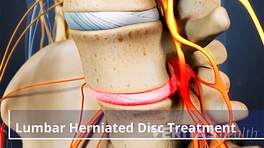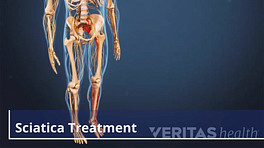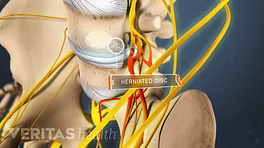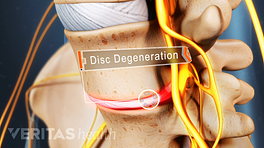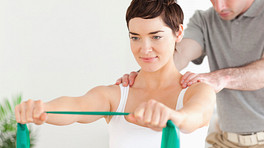The term sciatica refers to a set of symptoms, such as pain, tingling, numbness, or weakness that radiates along your sciatic nerve—which typically courses from your lower back down to your feet.
The medical term for sciatica is lumbar radiculopathy—a condition where spinal nerve roots in the lower back get irritated or compressed, sending pain and/or neurological symptoms into your lower extremities.
You might be surprised to learn that one of the most common causes of sciatica is a lumbar herniated disc. Read on to find out more about how a lumbar herniated disc can result in searing pain in your leg or numbness in your foot.
Read more about Sciatica Causes
Herniated discs can irritate your sciatic nerve roots
Your lower back (lumbar spine) carries a significant amount of weight and is constantly in motion, making your spinal discs susceptible to injury and pain. An injury to your disc can cause the inner soft core (nucleus pulposus) to migrate from its normal position and push against the fibrous outer layers (annulus fibrosus). It is also possible for the soft material to leak out by tearing the fibrous rings.
- Your discs are typically located in close proximity to your spinal cord and spinal nerve roots (part of a spinal nerve as it exits the spinal cord). 1 Dulebohn SC, Ngnitewe Massa R, Mesfin FB. Disc Herniation. [Updated 2019 Aug 1]. In: StatPearls [Internet]. Treasure Island (FL): StatPearls Publishing; 2019 Jan-. Available from: https://www.ncbi.nlm.nih.gov/books/NBK441822/
- The sciatic nerve is one of several nerve roots that can be affected by a herniated disc. Each lumbar nerve root sends pain into a different part of the leg. 2 Wright R, Inbody SB. Radiculopathy and Degenerative Spine Disease. In: Neurology Secrets. Elsevier; 2010:121-130. doi:10.1016/b978-0-323-05712-7.00007-6
- When a disc herniates, it can
3
Kumar, M. Epidemiology, pathophysiology and symptomatic treatment of sciatica: A review. nt. J. Pharm. Bio. Arch. 2011, 2.
:
- Leak out chemical substances to inflame one or more of the sciatic nerve roots.
- Cause a direct mechanical compression of the nerve root.
See Diagnosing a Lumbar Herniated Disc
Sciatica pain and neurological symptoms, such as numbness, tingling, and/or weakness then travel down from the affected nerve root into your leg and foot.
Read more about Sciatica Symptoms
4 guidelines to prevent sciatica if you have a herniated disc
Common daily activities, such as bending, lifting, twisting, and prolonged sitting may contribute to disc herniation. Changing questionable routines and implementing new practices can help you prevent a new disc herniation and/or recurrent irritation of your sciatic nerve roots from a previously herniated disc.
1. Protect your discs after sustained sitting or bending
Long periods of sitting or bending can increase the load on your discs by almost 40%, 4 Amin RM, Andrade NS, Neuman BJ. Lumbar Disc Herniation. Curr Rev Musculoskelet Med. 2017;10(4):507–516. doi:10.1007/s12178-017-9441-4 making them susceptible to injury. Avoid lifting and/or performing high energy tasks after prolonged sitting or bending. For example, avoid lifting a bag of soil after bending and weeding for a long time or lifting heavy luggage after sitting during a long drive or flight. 5 Morgan W.E, Herniated Disc A Survival Guide. 2nd ed. 2012. , 6 McGill, S.M., Low Back Disorders: Evidence-Based Prevention and Rehabilitation. 3rd ed. Human Kinetics, Incorporated; 2015. https://books.google.com/books?id=ePF6DwAAQBAJ
Stand straight for a few minutes and allow your discs to recover and reshape before attempting sudden or exertive movements.
2. Maintain a safe lumbar arch when you bend
We bend our spine often, such as while doing household chores, lifting something off the floor, working, or sitting. Maintaining a safe lumbar arch while performing these activities can help prevent or worsen disc herniation by reducing the stress on your discs.
While bending, you can maintain a safe lumbar arch by:
- Bending at your knees while lifting something off the floor
- Pivoting at your hips and not your spine while leaning forward
- Using the golfer's lifting technique for lifting small objects
- Moving a heavy object by pushing rather than pulling
- Resting one leg on a footstool if required to stand for a long time, such as while washing dishes
- Sitting with the shoulders rolled back and maintaining the natural alignment of the spine
Also, make a conscious effort to avoid stooping, hunching, or slouching when you bend, stand, walk, or sit.
3. Use assistive aids to reduce disc pressure
You can minimize the stresses on your discs caused by using assistive devices such as:
- Luggage with wheels (preferably 4 wheels vs. 2)
- Grocery or laundry carts vs. baskets
- Pillows placed between your legs (for side sleepers) or under your knees (for back sleepers) while sleeping. See What to Look for in a Pillow if You Have Sciatica
When you use these aids on a daily basis, it may protect your sciatic nerve roots from constant irritation of a lumbar herniated disc.
4. Perform back extension exercises
Exercises that let you bend your spine backward, such as the McKenzie technique may be helpful in relieving pain from a herniated disc. These exercises help centralize your sciatica pain, which may be helpful in treating and healing the disc herniation. 5 Morgan W.E, Herniated Disc A Survival Guide. 2nd ed. 2012.
It is important to learn extension exercises from a trained physical therapist to ensure correct form and technique and avoid other complications.
When you have sciatica from a herniated disc, exercises that include repeated forward bending or twisting are usually not advised and must be avoided. 5 Morgan W.E, Herniated Disc A Survival Guide. 2nd ed. 2012.
See Exercise for Sciatica from a Herniated Disc
If your lumbar herniated disc causes persistent or severe sciatica symptoms that are not relieved by self-care, visit a doctor for an accurate diagnostic checkup and supervised medical treatment. Severe disc herniation can cause medical emergencies, such as cauda equina syndrome, 7 Fairbank J, Mallen C. Cauda equina syndrome: implications for primary care. Br J Gen Pract. 2014;64(619):67–68. doi:10.3399/bjgp14X676988 which causes bowel and/or bladder dysfunction, numbness in the genital region, and/or severe leg weakness. Consult your doctor immediately if you experience one or more of these symptoms.
Learn More:
- 1 Dulebohn SC, Ngnitewe Massa R, Mesfin FB. Disc Herniation. [Updated 2019 Aug 1]. In: StatPearls [Internet]. Treasure Island (FL): StatPearls Publishing; 2019 Jan-. Available from: https://www.ncbi.nlm.nih.gov/books/NBK441822/
- 2 Wright R, Inbody SB. Radiculopathy and Degenerative Spine Disease. In: Neurology Secrets. Elsevier; 2010:121-130. doi:10.1016/b978-0-323-05712-7.00007-6
- 3 Kumar, M. Epidemiology, pathophysiology and symptomatic treatment of sciatica: A review. nt. J. Pharm. Bio. Arch. 2011, 2.
- 4 Amin RM, Andrade NS, Neuman BJ. Lumbar Disc Herniation. Curr Rev Musculoskelet Med. 2017;10(4):507–516. doi:10.1007/s12178-017-9441-4
- 5 Morgan W.E, Herniated Disc A Survival Guide. 2nd ed. 2012.
- 6 McGill, S.M., Low Back Disorders: Evidence-Based Prevention and Rehabilitation. 3rd ed. Human Kinetics, Incorporated; 2015. https://books.google.com/books?id=ePF6DwAAQBAJ
- 7 Fairbank J, Mallen C. Cauda equina syndrome: implications for primary care. Br J Gen Pract. 2014;64(619):67–68. doi:10.3399/bjgp14X676988



